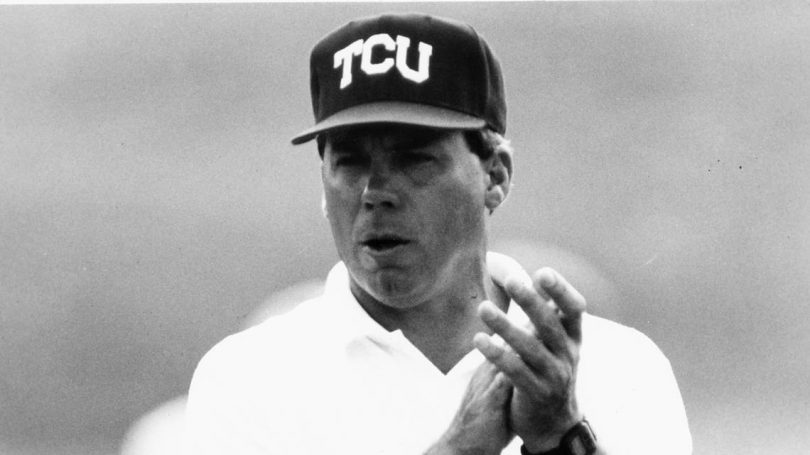One of the first things Pat Sullivan did after becoming TCU coach was take a look at the weight room and shake his head.
“I bet it was 40 feet by 80 feet,” former quarterback Max Knake said. “The AC was probably one wall unit, and same with the heater.”
Sullivan, a Heisman Trophy winner from blue-blood Auburn, knew he had work to do with the Horned Frogs’ sleepy program when he took over in 1992. Immediately, the changes ranged from the cosmetic — an arched TCU logo that replaced the Flying T — to the schematic — a pro-style, two-back offense — to the physical — calling for facility upgrades and a grass playing field.
“People got tired of him saying that at Auburn we used to do this, at Auburn we used to do that,” TCU radio analyst John Denton said of the former coach, who died early Sunday morning at his home in suburban Birmingham, Ala., at age 69. “But I mean, TCU needed to be thinking like Auburn. He kind of dragged TCU into that mindset.”
In three seasons, it paid off when Sullivan forged a Southwest Conference championship team as TCU shared the 1994 title with Texas, Texas Tech, Baylor and Rice. The fact that first-place Texas A&M was ineligible for the title because of NCAA penalties mattered not — the Horned Frogs were league winners for the first time since the 1950s.
“I did every one of his games on radio, and I will tell you, he was as good a playcaller and coordinator as I’ve ever seen,” Denton said. “His creativity in the screen game was unbelievable — screens to the back, screens to the tight end. They were a two-back pro set utilizing a tight end that could run. It was pretty sharp stuff. He was almost a little ahead of his time.”
A funeral is scheduled for 1 p.m. Friday at the Grant Mills campus of Church of the Highlands in Birmingham.
“He told me before the season in ‘92: ‘We’re rebuilding, but we’re going to beat Texas because I know what we need to do to beat them,’ ” Denton said. “Sure enough, he did. They ran draws and screens and slants the whole game and beat ‘em. They screened Oklahoma to death in the opening game of ‘96 up in Norman. Pat could call a game.”
Before recasting the mindset of the players at TCU, Sullivan set change in motion just in his interviews with the search committee led by university trustee Malcolm Louden.
“We got all of his thoughts about what we were doing, what we were not doing enough,” Louden said, recalling the era just before the breakup of the Southwest Conference that was starting to make TCU well aware of its limitations. “It literally made a change in what we were thinking about football and athletics. We had let ourselves fall behind in facilities. It changed our whole attitude. It made us step up.”
TCU promised to switch to a grass field and did. The Frogs also needed a practice field adjacent to the locker room and coaching offices. Prompted by Sullivan, the school redesigned its uniforms to a cleaner, traditional two-tone look.
“We were walking a mile to practice every day,” safety Landry Burdine said. “He was pushing to get that changed. The uniforms, he was kind of a trendsetter there. He went with the arched TCU. He went with the silver helmet. All the things that everybody applauds coaches for doing now, he was doing back then.”
Just as efficiently, Sullivan began winning recruits, notably Knake, a prolific passer out of McKinney who had his eyes on Texas. The coach’s reputation as a Heisman-winning quarterback, offensive coordinator for Pat Dye at Auburn and soft-spoken gentlemanliness did the trick.
“When I met Coach Sullivan, that, combined with Fort Worth, felt like a second home to me,” Knake said. “My memories of our first conversation was that it was just comfortable. I think that was felt by pretty much everybody he brought into TCU. Then the improvements that he made to the facilities, the weight room, the practice fields, the training table — everything that he did, he was moving it to a first-class program. He took us a long way in a short period of time.”
Sullivan’s recruits included Tomlinson, the school’s all-time leading rusher and scorer, and Schobel, No. 1 in sacks. Both players were part of the 1998 team that won the school’s first bowl game in 41 years. Tomlinson is a Pro Football Hall of Fame member and the Chargers’ franchise rushing and touchdowns leader. Schobel made two Pro Bowls in an eight-year NFL career and is second on the Bills’ sack list.
“He had an eye for talent, and he could recruit Texas,” Burdine said. “He spoke the South. He could recruit in the South.”
Sullivan coached at TCU through a 1-10 campaign in 1997, the lone victory coming in the season finale against SMU. With the Frogs struggling on the field and mired in controversy surrounding player-involved fights in Fort Worth and Dallas over a two-year period, plus multiple suspensions and a positive random steroid test, the coach announced his resignation a month before the end of the season.
“We were completely demoralized, but they kept coaching hard,” Landry said of Sullivan and staff. “They never let up, even though none of them had a job at the end of the season. It was a credit to them that we beat a good SMU team, and a lot of that was because they kept coaching hard.”
Sullivan’s final two seasons were also hampered by knowledge that he had accepted the head coaching job at LSU, only to have the offer fall apart.
“I had to go to TCU and actually get my job back,” Sullivan said in a 2016 interview with Auburn 247 Sports. “The whole thing really hurt us in recruiting. We were building it back up, but things were never the same again.”
Sullivan departed with a 24-42-1 record in Fort Worth.
“That was a big deal to us to get a win for Coach Sullivan to go out on,” Burdine said. “I remember how happy he was in the locker room. We were all smiling and crying and jumping around.”
In 2003, as offensive coordinator at UAB, Sullivan received a diagnosis of throat cancer but continued to coach through his treatments, developing future NFL All-Pro receiver Roddy White. Sullivan became head coach at Samford in 2007 and won a Southern Conference championship before resigning in 2014, citing health reasons.
At UAB and Samford, like at TCU, Sullivan’s “Auburn Way” made a difference.
“TCU didn’t have the mentality that they needed to really invest in their program,” Knake said. “I think Coach Sullivan, what he did was bring in some guys that could play football, that were a little bit higher-stature recruits that gave the alumni and the school a lot of confidence to spend money and invest in the program.”
As a player, Sullivan led the nation in total offense as a junior in 1970 and won the Heisman as a senior with 20 touchdown passes. The Birmingham native was an All-American and the SEC player of the year both seasons.
It made Knake smile to think of his former coach on Saturday night as a certain big game was being contested at Auburn’s Jordan-Hare Stadium.
“I assume that he waited until that game was over before he passed,” Knake said, “so he could get one final win.”
(Photo TCU Athletics)







